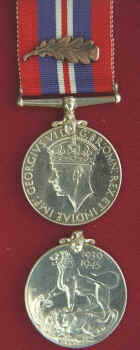The War Medal 1939-1945:

The British issue medals were made of cupro-nickel (others were silver (.800 fine), 36mm in diameter). The obverse shows the crowned coinage effigy of King George VI, facing left, and the legend GEORGIVS VI D : BR : OMN : REX ET INDIAE IMP :
The reverse shows a lion standing on the body of a double-headed dragon. The dragons heads are those of an eagle and a dragon to signify the principal occidental and oriental enemies. At the top, just right of centre are the dates 1939/1945 in two lines.
The ribbon is 1.25 inches wide and consists of 7 coloured stripes: red, dark blue, white, narrow red (centre), white, dark blue, and red, representing the colours of the Union Flag.The medals were issued unnamed; except those awarded to personnel of the Canadian Merchant Marine, RCMP, South African and Australian forces, which were named on the rim. A single bronze oak leaf emblem is worn to signify a 'Mentioned in Despatches' and a silver oak leaf is worn to signify an award of a King's Commendation for Brave Conduct. There is no bar other than these emblems. The War Medal in cupro-nickel is worth between £10 - £12. The Canadian version of the medal in silver is worth between £12 and £15.